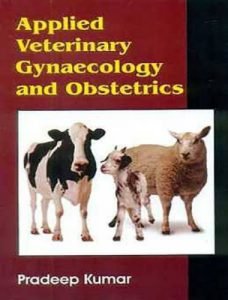Applied Veterinary Gynaecology and Obstetrics PDF
This book has been written by Pradeep Kumar and for the purpose to cover the practical and clinical aspects of
 Veterinary Gynaecology and Obstetrics. The author has tried to prepare this book in a unique manner. The matter has been presented in a very simple language and lucrative manner so that one can read this book in one breath. In many books, very exhaustive and huge informations are given but these are very boring task to read for undergraduate students and clinicians.
Veterinary Gynaecology and Obstetrics. The author has tried to prepare this book in a unique manner. The matter has been presented in a very simple language and lucrative manner so that one can read this book in one breath. In many books, very exhaustive and huge informations are given but these are very boring task to read for undergraduate students and clinicians.
The aim of the book is to tell a scientific and technically sound precise story instead of presenting a data base encyclopaedia on the subject. Therefore the materials has been arranged accordingly and the supplementary informations or more detailed explanations are given in the boxes which can be consulted at once or return to after the principal points have been grasped. For increasing the interest and to give the information of new advances in the field of Veterinary Gynaecology, the author has made his every possible effort.
For this, ‘Interesting Facts’, ‘Clinical Pointers’, ‘Do you know?’ ‘Points to Remember’ etc. have been incorporated in the boxes in between the matter. My main motto in compiling information in this book is to provide relevant information in a simple and interesting way so that matter should not appear difficult to understand by an average undergraduate students. A number of illustrations and photographs have been included to make each chapter meaningful. At the end of each chapter, ‘observations’ and’ exercise’ have been given which will help a clinician in testing his/her acquired knowledge and a student in preparing for examinations and viva-voce. It is hoped that this style of writing will encourage the use of this book for the final year B.V.Sc & A.H., students and Veterinary clinicians. Download More: Case Studies in Veterinary Immunology
This book also cover clinical cases of cattle and buffalo in an interesting way with new concepts. Wherever it becomes necessary to point out the old concepts of treatment, I did and highlighted the new concepts of treatments. Thus this book gives an information about latest trend of treatments and explain the disadvantages of adopting old trend of treatments.
In this book, various interesting and clinically important chapters have been included which are generally not given in the text books available in the market. For example, pregnancy diagnosis in small ruminants by ‘recto-abdominal palpation’, early pregnancy diagnosis in cattle by ‘milk ejection test’ etc. These are very-very simple and reliable techniques for diagnosis of pregnancy. Generally pregnancy diagnosis in small ruminants requires X-ray and ultrasound because only abdominal palpation is not confirmatory diagnosis.
However, use of these sophisticated methods are not feasible in the field conditions, whereas ‘recto-abdominal palpation technique’ gives 90-100 % accuracy without use of any sophisticated instrument. Likewise the author has tried to give as many such informations which can be applied in Indian field conditions.
This book has been divided into three parts. In the part I from chapter 1 to 17 are designed to help the final year students, beginners and clinicians to understand the anatomy and physiology of reproduction, gynaecological examinations and their applications to diagnose the clinical problems.
In part II, chapters 18 to 28 emphasize the application of basic concepts of obstetrical cases and their management. In this part, author has tried to explain the basic principles of obstetrics, which are generally over-looked in most of the books available in the market. For example ‘how to apply rope on the legs and head of foetus’, ‘how to prevent the inner wall of uterus and birth canal from the teeth and hooves of the foetus’, ‘what should be the direction for traction of rope in different stages’ etc. Separate obstetrical cases, their incidences, causes and treatments have not been discussed in detail. Foetotomy and caesarean section have been described in detail.
In part III, chapters 29 to 46 have been devoted to the therapeutic management of gynaecological problems. This part describes some of the problems that are commonly encountered in the field. The aim of writing this part is to at least provide a coherent overall therapy guide, create a stimulus and direction for greater in-depth study on particular chapter, and contribute a useful compilation of existing practical therapeutic knowledge for the veterinary undergraduates, clinicians and academicians.
Antimicrobial agents are the most frequently used and misused drugs in veterinary practice. A rational approach to antimicrobial therapy entails choosing the proper drug to be administered to the particular animals after considerations of potential benefits and risks. Prerequisites to rational therapy include a diagnosis, understanding of the pathophysiology of the disease and pharmacology of the drug and the establishment of therapeutic objectives. It is the purpose of this part to describe an approach to rational treatment of infections, which cause infertility in cattle and buffaloes. Part III also includes effect of homoeopathic medicines on the female genital tract. Hahnemann (1814) advocated their use in animals and so Veterinary Homoeopathy has a long tradition.
At the end of this book Applied Veterinary Gynaecology and Obstetrics PDF, ‘Glossary’ and’ Appendix’ have been given which will help the veterinary graduates in preparing for various competitive examinations, viva-voce examinations and interviews because these have been collected and arranged in a very lucid manner.
-
- Book Name: Applied Veterinary Gynaecology and Obstetrics PDF
- File Type: PDF
- Download: Link
- Size: 20 MB
- Password: PDFLibrary.Net
